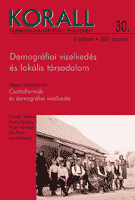Lelkészek képzése és elhelyezkedési esélyei a 19. század elején a Tiszáninneni Református Egyházkerületben
Education and Chances of Employment for Clergymen in the Beginning of the Nineteenth Century in the Protestant Diocese of East of the Tisza River (Tis
Author(s): János UgraiSubject(s): History
Published by: KORALL Társadalomtörténeti Egyesület
Summary/Abstract: The aim of this study is to defi ne the dimensions of education and the employment opportunities of protestant clergymen in Northeast Hungary two hundred years ago. The first half of the education of clergymen in the diocese was provided by the Protestant Collegium of Sárospatak. Here, young men preparing to become clergymen studied for 7–10 years after their elementary and secondary education. However, the large proportion of those who left school halfway through suggests that the Theology faculty played an important role not only in the supply of clergymen, but also in that of intellectuals of a lower degree. The education of clergymen was not complete with graduating from the Collegium. Ideally, it was followed by two two-three year long periods (village teachership and peregrination). Young men eligible for ordination usually served as curates or vice-clergy. Thus, from the time of enrollment in the academy to being awarded their first independent position as long as 15–20 years may have elapsed. This served as a selection period for candidates studying in the Collegium in much larger numbers than the diocese could employ, and also to allow time for a significant number of young men to fi nd other career choices. Although prelates of the church could not fully avoid entrant unemployment with this strategy, they were able to keep it under control to some extent.
Journal: Korall - Társadalomtörténeti folyóirat
- Issue Year: 2007
- Issue No: 30
- Page Range: 158-181
- Page Count: 24
- Language: Hungarian

